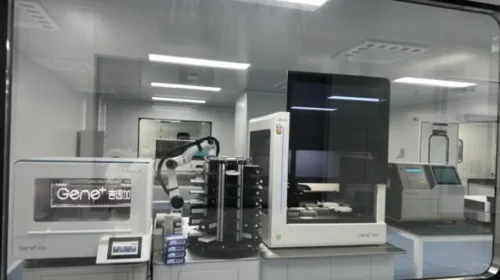Media reports said the autonomous driving aspirant plans to take its robotaxis global, though it’s likely to stay focused on its home China operations for now
Key Takeaways:
- Baidu’s reported international robotaxi expansion plans look more like strategic narrative to show future potential rather than an immediate priority
- The company’s robotaxi operation aims to break even in Wuhan by year-end, with overall profitability for the business projected for 2025
By Hugh Chen
Tesla’s “We, Robot” event was the talk of the autonomous driving world, as the company unveiled its long-teased robotaxis to mixed reviews on Oct. 10. But just two days earlier, Baidu Inc. (BIDU.US; 9888.HK) grabbed its own robotaxi headlines with reports of plans to take its similar program outside its China base, showing the company was aiming to keep up with hometown rivals like WeRide and Pony.ai, as well as Google’s Waymo.
But the reports, all from unnamed sources, may be more talk than any immediate action plan, planted by Baidu to show it’s also in the global robotaxi race as a direct competitor to Tesla and the others.
The Wall Street Journal was one of several media reporting Baidu’s global ambitions, saying last week the company planned to test and deploy its Apollo Go robotaxis in locations including Hong Kong, Singapore, and the Middle East. The report said Baidu has been discussing such plans with local companies and regulators in those regions.
The leaks seem designed to fuel investor interest in Baidu’s autonomous vehicle business, which has gained significant traction after a decade of quiet development. The company recently projected that its robotaxi operations in the Central Chinese city of Wuhan, where the majority of its fleet is deployed, will break even by year-end, with the overall business becoming profitable by 2025.
Baidu likely sees international expansion as a factor in achieving the scale necessary to earn meaningful profits from its decade of investment, adding a compelling growth narrative to its autonomous driving story. Despite its heavy investment in autonomous driving and a wide range of other areas over the years, Baidu still relies overwhelmingly on its original internet search business for most of its profits. It has been trying to diversify to show it’s more than just a one-trick pony, but without success so far.
Baidu’s stock has seen a notable uptick over the last two months, with its Friday closing price up 28% from its early September low. Much of that isn’t directly related to the company’s robotaxi developments, but rather to a broader recent rally for Chinese stocks fueled by recent signs that Beijing will take more aggressive steps to stimulate the country’s economy.
Interestingly, investors reacted somewhat cautiously to the news of Baidu’s overseas expansion plans, signaling they may not be so eager for such major new expense for a program that has plenty of potential already in China. On Oct. 9, the day the news first broke, Baidu’s shares edged down 2.7%.
It’s important to note that self-driving technology is not expected to power Baidu’s top-line revenue anytime soon. Despite its frequent refrain that it is transforming from an advertising-dependent internet search firm into an AI powerhouse, investors should be mindful of the multiple challenges Baidu faces in commercializing this technology.
Such hurdles extend beyond simple competition, which is always growing. Baidu must also navigate issues common to the entire autonomous vehicle industry: refining the still-maturing technology, addressing complex regulatory requirements across different jurisdictions, and overcoming public skepticism about the safety and reliability of self-driving vehicles.
A new growth driver?
As of July, Baidu reported that its robotaxi service had surpassed 7 million cumulative rides across 11 Chinese cities. During its latest quarterly earnings call in August, company executives said that 899,000 rides were provided to the public in the second quarter of 2024, representing a 26% year-over-year increase.
While seemingly impressive, much of the increase comes from a relatively new commercial venture. Apollo Go only began its commercialization efforts in 2022, when Baidu was among a select few companies granted licenses in Wuhan and Chongqing to operate fully driverless vehicles on public roads for commercial services, without onboard safety operators.
Since then, the service has expanded to additional cities, coinciding with more Chinese municipalities following Wuhan and Chongqing’s lead in permitting commercial robotaxi operations.
Despite the impressive ride numbers, Baidu has yet to disclose revenue figures for its robotaxi service, suggesting its financial contribution may still be minimal.
The future success of Baidu’s robotaxi service will depend on the company’s ability to keep expanding its fleet and enter more cities. While Baidu hasn’t revealed its total number of deployed robotaxis, it has said that it operates 500 vehicles in Wuhan alone, 400 of those fully driverless. It plans to increase this fleet to 1,000 by the end of the year.
Baidu is focused on cost reduction to achieve that rapid expansion and reach its profitability goals, aiming to lower hardware costs by outsourcing vehicle production to third-party firms. It’s also trying to optimize costs associated with safety monitoring, which is conducted remotely in some cities and onboard in others.
A July report from JPMorgan projects that Baidu’s robotaxi operation could reach breakeven in a few select cities in the second half of this year, based on the expected introduction of next-generation vehicles and significant changes to the ratio of vehicles per safety monitor.
Despite its cost-reduction efforts, Baidu’s pace of expansion also depends on factors beyond its control, particularly on the regulatory front. While the Chinese government is keen to advance self-driving technology, especially to stay competitive with the U.S., it’s also proceeding cautiously.
That caution was evident in July when Baidu’s long-term deployment of robotaxis in Wuhan suddenly sparked debate when some drivers complained about job displacement. That issue is particularly sensitive in China’s current slowing economy that has led to widespread job losses, with many viewing taxi driving as a sort of last-resort employment.
Moreover, Baidu isn’t alone in the Chinese robotaxi market, which the JPMorgan report projects will reach 1.33 trillion yuan ($188 billion) by 2033. Pony.ai and WeRide, which are both exploring public listings, are in the race as well, and so is electric vehicle maker Xpeng. WeRide is already developing its services in multiple overseas markets, and last month announced a new partnership to offer its robotaxi services in the United Arab Emirates through Uber.
At this stage, overseas expansion appears to be more of a future plan rather than immediate priority for Baidu, as the company is expected to focus on building up the product and honing the technology in the domestic market in the near term. Such technology is only making it to the mass market slowly, despite all the hype, and it’s far from clear when the pace of adoption may finally start to accelerate.
To subscribe to Bamboo Works free weekly newsletter, click here






